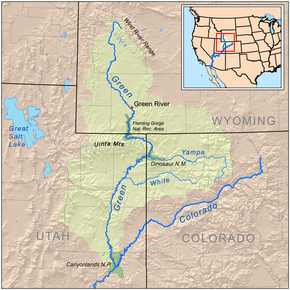Yampa River
| Yampa River | |
| River | |
 The Yampa River, c. 1871–1878 | |
| Country | United States |
|---|---|
| State | Colorado |
| Tributaries | |
| - left | Bear River, Williams Fork |
| - right | Elk River, Little Snake River |
| Cities | Steamboat Springs, Craig |
| Source | Rocky Mountains |
| - elevation | 7,833 ft (2,387 m) [1] |
| - coordinates | 40°9′30″N 106°53′59″W / 40.15833°N 106.89972°W [2] |
| Mouth | Green River |
| - location | Dinosaur National Monument |
| - elevation | 5,080 ft (1,548 m) [1] |
| - coordinates | 40°31′44″N 108°59′3″W / 40.52889°N 108.98417°WCoordinates: 40°31′44″N 108°59′3″W / 40.52889°N 108.98417°W [2] |
| Length | 250 mi (402 km) [3] |
| Basin | 7,660 sq mi (19,839 km2) [4] |
| Discharge | for Deerlodge Park |
| - average | 2,069 cu ft/s (58.59 m3/s) [4] |
| - max | 33,200 cu ft/s (940.12 m3/s) |
| - min | 1.9 cu ft/s (0.05 m3/s) |
 The Yampa River is shown on this map of the Green River watershed
| |
The Yampa River is a 250 mi (402 km) long river in northwestern Colorado, of the Southwestern United States. It is a tributary of the Green River, and so contributes into the Colorado River.
The name is derived from the Snake Indians word for the Perideridia plant, which has an edible root. John C. Frémont was among the first to record the name 'Yampah' in entries of his journal from 1843, as he found the plant was particularly abundant in the watershed.
Geography
Course
The Yampa River is formed from the confluence of the Bear River and Phillips Creek just east of the town of Yampa in northwestern Colorado in Routt County.[2] From Yampa, Colorado, the river flows north through Steamboat Springs, where it turns abruptly west. Near the small town of Milner the Elk River joins the Yampa which continues west in the plateau region along the north side of the Williams Fork Mountains, past the town of Craig. It is joined by the Little Snake River in Lilly Park,[Moffat County, Colorado]. Finally, the Yampa meets the Green at Echo Park in Dinosaur National Monument, near the border with Utah.[2]

Volume
The Yampa River forms a noticeably wide, shallow stream throughout much of its course. The lower three fourths of the Yampa, from the Elk river down, are navigable by small craft. However the meandering, shallow nature of the river can render the river unnavigable during late summer in low water years. The discharge of the Yampa varies from about 600 ft³/s (17 m³/s) during low water summers to 20,000 ft³/s (600 m³/s) in spring runoff. Average flow at its confluence with the Green is about 2500 ft³/s (71 m³/s).
Diversion proposal
In December, 2006, a report proposed to pump water from the Yampa River 200 miles east, under the Continental Divide, to the state's major cities along the Front Range. The diversion was proposed to start near Maybell, 20 miles (32 km) downstream of Craig, Colorado .[5][6]
The proposal faces widespread opposition because it could lower river flows in late summer due to the diversion. The Yampa is one of the West's last wild rivers since it has only a few small dams and diversions.
See also
References
- ↑ 1.0 1.1 Google Earth elevation for GNIS coordinates.
- ↑ 2.0 2.1 2.2 2.3 U.S. Geological Survey Geographic Names Information System: Yampa River, USGS GNIS.
- ↑ Yampa River, The Columbia Gazetteer of North America. 2000.
- ↑ 4.0 4.1 Water Data Report, Colorado 2003, from Water Resources Data Colorado Water Year 2003, USGS.
- ↑
- ↑
| Wikimedia Commons has media related to Yampa River. |